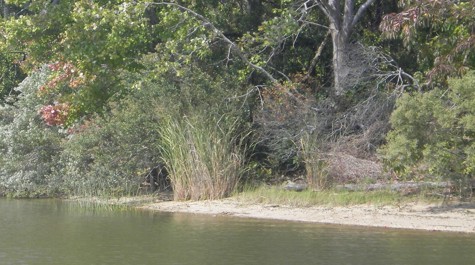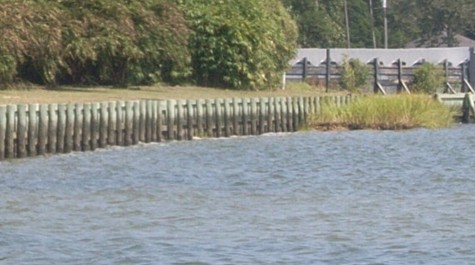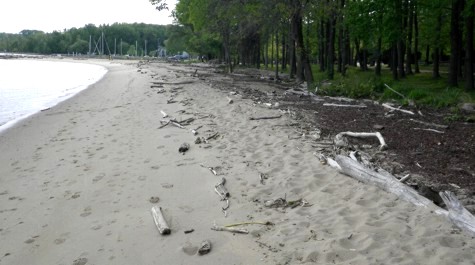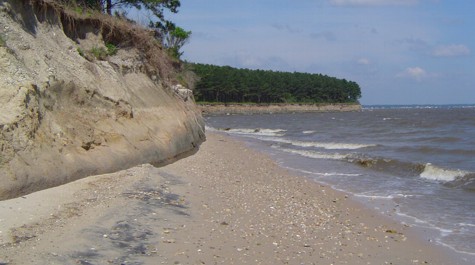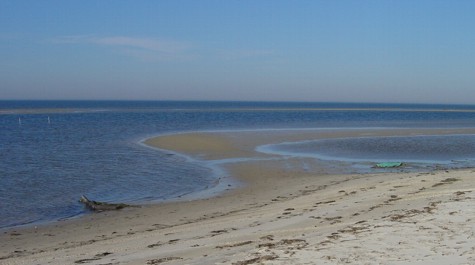Estuarine Beaches of the Bay
The estuarine beaches of Chesapeake Bay include unvegetated or partially vegetated sand, gravel, or shell intertidal beaches in a partially enclosed bay. While estuarine beaches are similar to their ocean counterparts in recreational and ecosystem services, they tend to be smaller in dimension. The function and dimension of a beach is influenced by wave action, and the physical type of sediment will vary depending on the geologic setting.
Geomorphically, a beach extends from below the low tide line to the landward limit of wave reworking during storms. Where beaches are wide enough and the conditions right, a dune can develop landward. The definition of a beach, as defined by the code of Virginia (§28.2-1400) is somewhat more complex; however, it can be summed up as sand occurring above the mean high water line to a backshore feature such as a dune, woods, or a structure.
The intertidal beaches in Chesapeake Bay and along its tributaries are created by locally-generated waves and wave-induced currents. Fetch is the distance over open water that wind can blow and generate surface waves, which varies greatly depending on the site location within the Bay. Smaller creeks have less fetch exposure, i.e. less energy, and consequently have fewer beaches because the smaller amount of energy does not move sand and larger grains resulting in sediment accumulating and creating a fringe marsh along the shore. Because many homeowners have bulkheaded their shoreline; with continued erosion over time, existing beach and marsh habitats have been lost. Along more exposed areas of the Bay with greater fetch exposure, beaches will be bigger due to the hydrodynamics of the system. In addition, because the wave energy is higher, the potential for erosion is greater putting more sediment in the alongshore sand transport system. Most sandy shorelines occur along the main shoreline of Chesapeake Bay, as well as the rivers and smaller bays that feed into it. 

Estuarine beaches will develop in a variety of geomorphic settings, from small pocket beaches, to longer linear features, to spits. Many beaches exist in front of marshes and creek mouths in addition to upland banks. Factors such as wave climate, tide range, sediment source, shore orientation, and shore morphology all help determine the dimensions of an estuarine beach system, and configurations vary greatly. Some beaches exist as sand only in the intertidal area of a coast while others have well developed nearshore bars and dune systems. Shoreline orientations can differ greatly over short distances, causing greater differences in exposure to dominant winds which will isolate beach segments and limit alongshore sediment exchanges.
Ecosystem Services
Estuarine beaches and dunes provide a setting for a variety of ecosystem services (ecosystem services are the benefits resulting from the resources and processes that are supplied by habitats). These include but are not limited to habitat, nutrient uptake, food production, wave attenuation, sediment stabilization and recreation. These sheltered coastal environments provide habitat for a variety of organisms. The shallow refuge areas of shore face environments provide suitable conditions for pupping some shark species. Some turtle species nest on upper beaches and within low dune areas in bays and estuaries. Estuarine beaches are home to endangered or threatened species.
Natural beach litter in wrack lines on the foreshore or backshore tend to be more prevalent on low energy beaches due to the large amounts of vegetation growing in sheltered waters and the numerous breaks in shore orientation. This material can have a pronounced effect on beach topography and dune accretion. The beach detritus also provides habitat and food for meiofauna.
More Information
Sands of the Chesapeake describes the origin of our sandy shores.
The beaches along rivers and creeks were analyzed by Shoreline Studies Program. For more detailed information, go to “Tidewater Virginia’s Non-Jurisdictional Beach Assessment”. Note: At the time the research was performed, the 17 localities studied were not managed by the Coastal Primary Sand Dunes and Beaches Act. However, the Act was updated in 2008 to include all tidal localities in the Bay.
Locations of Public Beaches in Virginia for Swimming or Wading.
EPA Fact Sheet – The Beach and your Coastal Watershed

